Sicily's Most Legendary Private Villa Has Reopened As a Luxury Hotel

Federico Ciamei The Villa Igiea pool terrace incorporates ancient ruins.
On an April morning in 1907, a three-masted yacht, the Victoria and Albert, dropped anchor at the northern end of the Bay of Palermo. Royal banners flapped in the wind while officers and cadets in smart naval uniforms swarmed over polished decks. Rumors quickly spread through the streets of Palermo, and crowds began to gather on the quays, hoping for a glimpse of the passengers. As the tenders were being lowered, people craned their necks for a better view of the burly gentleman in a homburg hat who was boarding one of the boats. Edward VII, the king of England, had come to call on the Florio family at the Villa Igiea.
At the beginning of the 20th century, when the Sicilian capital was as fashionable as Nice, the Villa Igiea's guest book read like an international Who's Who. In a cosmopolitan whirl of balls and costume parties, cocktail receptions and gala dinners, Archduke Franz Ferdinand of Austria, Tsar Nicholas II, Queen Marie of Romania, Constantine I of Greece, and Vajiravudh, the king of Siam, all came to stay. The Vanderbilts turned up in their yacht, as did Nathan Rothschild and J. P. Morgan. Opera singers, playboys, minor aristocrats, and that new phenomenon, movie stars, all followed.

Federico Ciamei From left: Curtains used to deflect sunlight in Palermo; a bust of Igiea, the Roman goddess of health, at Villa Igiea.
But few of the ladies wafting in their enormous bonnets among the oleander on the garden terraces, or the gentlemen smoking cigars by the seawall, could see the shadows that were encroaching on their famous hosts. In those careless years, there was still an enigmatic, Gatsby-like aura around Ignazio and Franca Florio. They appeared effortless, elegantly poised in a life of privilege and wealth. Having inherited one of the country's greatest fortunes at the age of 23, Ignazio was, in the words of The New York Times, one of the merchant princes of Europe. The daughter of one of Sicily's old aristocratic families, Donna Franca was "tall, slender, supple, swaying," in the description of poet Gabriele d'Annunzio. Palermitans dubbed her the Queen of Palermo.
Palermo is the most underrated city in Italy. I would rather spend a day there than a week in Florence. It is chaotic, seductive, swaggering, unruly, and endlessly charming.
The family was the Italian equivalent of the great 19th-century American commercial dynasties like the Rockefellers, Carnegies, and Gettys. In the 1780s, Paolo Florio arrived in Palermo from Calabria and opened a humble spice shop. Four generations later, the Florios dominated the economic life not just of Sicily, but of Italy, with interests in shipping, shipbuilding, railways, mining, metallurgy, fishing, ceramics, and wine. They were said to employ 16,000 people. They founded a newspaper and a bank. They ran 90 ocean liners to all points of the globe. When they bought and redesigned a villa overlooking Palermo Bay, they created both a grand hotel for a glittering clientele and a Florio palace.
I had come to see the resurrection of this great hotel, an icon of the Belle Époque, and to revisit Palermo, a city I adore. But in the rooms and elegant dining halls, and out on those dreamy tiered gardens overlooking the bay, it was impossible to escape the presence of the Florios. I found myself tracing the way those delirious days and nights among their famous guests had been overtaken by heartbreak, and by the family's eventual exile from the Villa Igiea.
Palermo is the most underrated city in Italy. I would rather spend a day there than a week in Florence. It is chaotic, seductive, swaggering, unruly, and endlessly charming. It veers between bellowing backstreet neighborhoods and grand monuments of soaring beauty. It is impossible to understand Italy, Goethe said, without visiting Sicily. He called it the "clue to everything."
A millennium ago, Sicily lay at the center of the world. The island has Phoenician ruins, Carthaginian shipwrecks, Greek temples, Roman villas, Arab pleasure palaces, and Bourbon castles. When the Normans arrived, they seized upon the tradition of Byzantine mosaics and made those shimmering surfaces all their own. Up in the town of Monreale, the nave of the great Norman cathedral swims with golden light, while down in the center of Palermo the mosaics of the Capella Palatina are some of the masterpieces of European art.

Federico Ciamei From left: A classic Favignanan decorative detail; the view of the Mediterranean from Cas’almare, a guesthouse on Favignana’s northern coast.
Like Milan and Florence and Venice, Palermo was a royal capital, and it boasts palaces the way Manhattan boasts skyscrapers. Around every corner there is another colossal pile. Some have become crumbling tenements, barnacled with laundry; some have been reimagined as museums. But many are still inhabited by old aristocratic families.
In the early decades of the 19th century, the entrepreneurial Florios stepped into this antique world, so exquisitely evoked in Giuseppe di Lampedusa's novel "The Leopard." Like many successful business families, they married into an increasingly impoverished aristocracy, swapping their wealth for social cachet. Ignazio's father, Ignazio Sr., had married a Sicilian baroness. Ignazio himself proposed to Francesca Paola Jacona della Motta dei Baroni di San Giuliano, commonly known as Donna Franca. Any objections from her father had nothing to do with the family's humble origins. He was more concerned about Ignazio's reputation as a womanizer.
At the beginning of the 20th century, the Villa Igiea's guest book read like an international Who's Who.
He was right to worry. Soon after their wedding, Ignazio went on safari in North Africa with 50 porters. You would have thought one of them might have removed the women's underwear from his luggage, which was discovered by Donna Franca on his return. It was only the first of many indiscretions. In Giovanni Boldoni's famous portrait of Donna Franca, which once hung in the Villa Igiea, she wears a long string of pearls. It is said Ignazio gave her a pearl every time he needed to ask for her forgiveness. Apparently there are 365 — one for every day of the year.
A picture was emerging of this golden couple: Ignazio, wayward, spoiled, impulsive, easily tempted; Donna Franca, determined, intelligent, constant, confident. When Ignazio invited the opera singer Lina Cavalieri, frequently described at the time as the most beautiful woman in the world, to sing at the Teatro Massimo, Donna Franca knew what was going on. She employed a boisterous claque to whistle during the performance while she sat in the royal box, looking imperious. Cavalieri left the stage on the verge of tears and departed Palermo the following morning.
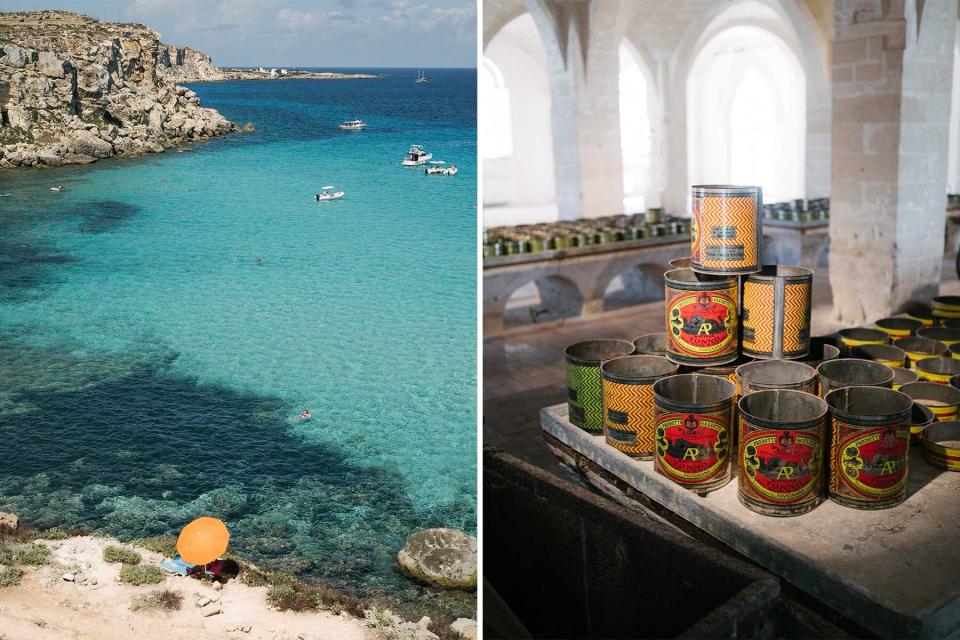
Federico Ciamei From left: Cala Rossa, a popular cove on the island of Favignana; the former Florio tuna-packing plant, now a museum.
Donna Franca's stage was the Grand Hotel Villa Igiea, its cast of admiring celebrity guests a consoling audience. Designed by the famed Palermo architect Ernesto Basile and opened in 1900, the villa is a masterpiece of Belle Époque modernism, a style known in Italy as Liberty — named for the London department store. After the Florios were forced to sell the property in 1929, it continued to operate as a hotel through the 20th century. But it was a ghost of its former self. Under a succession of owners, it grew increasingly frayed around the edges. Finally bankruptcy loomed, and in 2019 the hotel was bought at auction by Rocco Forte, the British hotelier with Italian roots, for $29 million.
The old hotel has been fortunate in its new suitor. Forte has an impressive portfolio of properties, including Browns in London, the Hotel Astoria in St. Petersburg, and the Hotel de Russie in Rome. The renovation was undertaken by designers from the London firm of Nicholas Haslam, Philip Vergeylen and Paolo Moschino, who worked in close collaboration with designer Olga Polizzi, Forte's sister. Their brief was not to change the character of the hotel but to bring it back to life. While the bedrooms have been expanded and beautifully reworked to meet modern expectations of a luxury hotel, the focus in the grand public spaces has been on restoration.
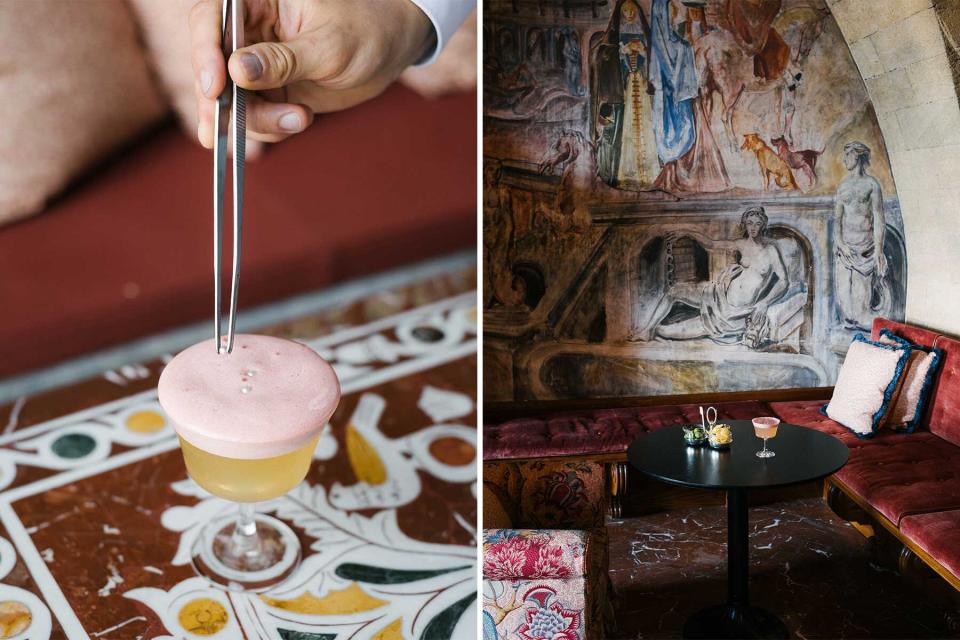
Federico Ciamei From left: The Donna Franca cocktail, made with gin, champagne, fruit syrups, and cherry foam, at the Igiea Terrazza Bar; the bar occupies the hotel’s sandstone vaults.
Students from the Academy of Fine Arts were brought in to refurbish the murals in the splendid Sala Basile, where fair maidens stroll among peacocks and giant irises. The library, where the morning newspapers await among the sofas and writing desks, still feels like a salon of the early novecento. Down in the Terrazza Bar, with its elegant globe lamps and leather seats, you might be stepping onto the set of a Fred Astaire film. The terraced gardens, which are anchored by an oblong pool and a folly of Greek columns, look like an old friend who has turned up in a splendid new suit. To dine at the restaurant, Florio, as warm dusk filters through the umbrella pines and necklaces of lights appear on the far side of the bay and the ferries push out of the harbor heading for Naples and Genoa and Tunisia, is one of life's great delights.
Related: 12 of the Best Small Towns in Italy
Yet the Villa Igiea is not just a grand building. It is a community of people, buzzing in a way that it has not done for almost a century. I have rarely been in a hotel where the staff were so engaged. Everyone, from the concierge to the doormen, seemed delighted at the return of Palermo's grande dame. The chefs kept popping out to greet guests, while the waiters, over the course of just three days, became my friends. I spent an hour in the library with the concierge talking all things Igiean, and the young doorman turned out to be a Irishman drawn to Palermo by a love affair.
The resurrection of the Villa Igiea is timely. Palermo is experiencing a renaissance, too. Art galleries, smart cafés, and restaurants featuring young Sicilian chefs are opening in restored palaces. The colossal Palazzo Butera, which overlooks the harbor in the Kalsa quarter, has been turned into a cultural center, library, and gallery. The Galleria d'Arte Moderna showcases contemporary work in the Sant'Anna convent. Meanwhile, another hotel in the Liberty style has been refurbished — the Grand Hotel et Des Palmes — a stone's throw from the 19th-century Teatro Massimo, still one of the largest opera houses in Europe, where Ignazio and Donna Flora once presided at Palermo's gala evenings.
But what of the Florios? How did they lose both their fortune and their dream palace?
I searched out two of the remaining descendants. Chico Paladino Florio is a cosmopolitan figure who owns properties in Madagascar and Brazil, as well as one of the last Florio villas in Palermo. In Rome I met Nicola de Rivera Costaguti, a charming elderly gentleman who calls Donna Franca "granny" and who still seems to embody the manners and style of the Belle Époque.
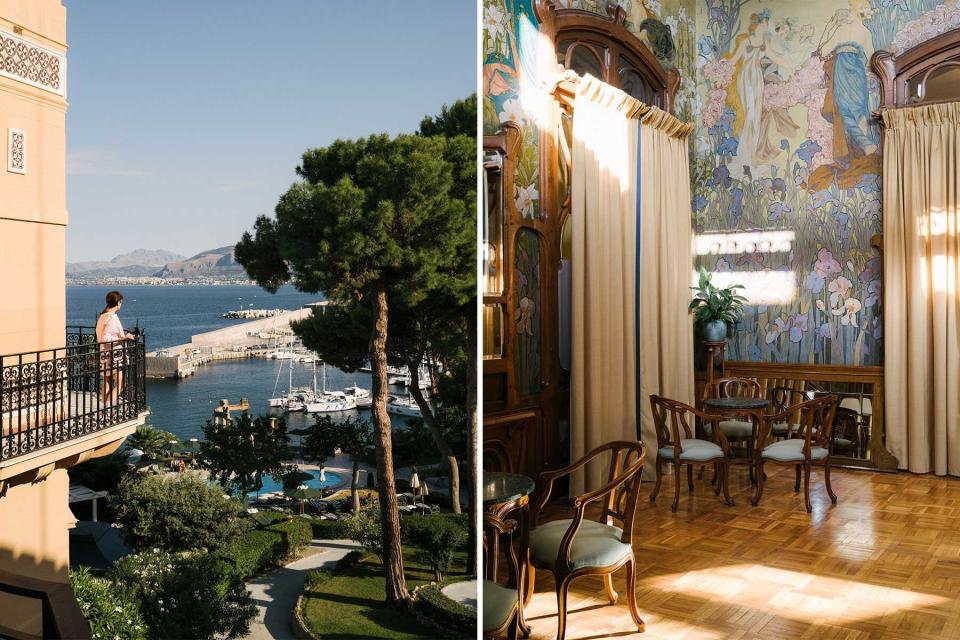
Federico Ciamei From left: Sicily’s Bay of Palermo, as seen from the Villa Igiea, now owned by Rocco Forte Hotels; original frescoes by the Neapolitan artist Ettore De Maria Bergler in the Sala Basile, Villa Igiea's main reception room.
In the warm twilight on the terrace of the Villa Igiea, Chico explained how the collapse of the Florios' commercial empire had many threads. For suspicious Sicilians, Italian unification was always a northern enterprise, and they are quick to accuse politicians like Giovanni Giolitti, prime minister five times between 1892 and 1921, of wanting to undermine Sicily and the power of dynasties like the Florios. State contracts were withdrawn and given to northern enterprises. Arbitrary government regulations seemed bent on crippling the Florio operations.
There were also question marks over Ignazio's commercial instincts. Having grown up with wealth, he enjoyed a sense of entitlement that was inimical to the kind of buccaneer innovation that had made the family's fortunes. He continued to spend lavishly as debts spiraled.
Related: 10 Places Where Italians Travel In Italy, According to a Local
But in the scented gardens of Rome's Hotel de Russie, Nicola alluded to a more personal story. In the space of 13 months between 1902 and 1903, Ignazio and Donna Franca lost three of their five children. One daughter, who was already suffering from tuberculosis, died of meningitis, while another lived only a few hours after her birth. Their only son, Ignazio, on whom hopes for the family's future rested, died of an unknown cause at the age of five.
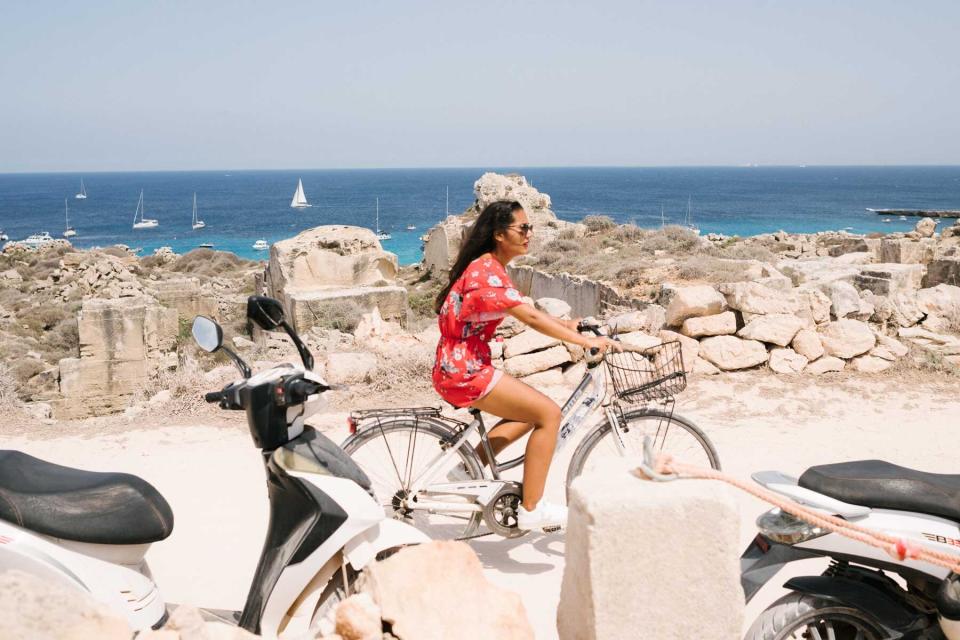
Federico Ciamei Bike riding by the sea on Favignana.
Heartbroken, the couple retreated to the island of Favignana, part of the Egadi archipelago off the western coast of Sicily. It has a special place in the family's history. In 1876, Ignazio Sr. bought the island and its lucrative fishing rights and created a tuna packing plant, where he introduced the idea of canning tuna in olive oil. The phenomenal success of this enterprise was one of the key foundations of the family's fortune. Every year the Florios spent happy weeks on the island. In old photographs, you can see Ignazio, a small boy in a big hat, among family and friends, squinting against the Mediterranean sun. I set off there from Palermo, following in their footsteps.
Favignana, though only five miles from the coast of Sicily, feels halfway to North Africa. It is not pretty or cute or lush. It is a bony place of limestone and tufa, of windswept trees and fields of rough grass dusted with wildflowers. There is a haunting edge-of-the-world beauty there—something about vast skies and empty, elemental landscapes. I found this cubist jumble at the port. No cars are allowed on the island beyond those of the locals, who are more likely to navigate the narrow meandering roads, which are lined with dry stone walls, on bicycles and scooters. Along the coast people swim from shelves of rock in seas that are as clear as a desert sky.
Few foreigners have discovered Favignana, but well-traveled Italians adore it. They have brought a sophistication to the island's simplicity. A handful of stylish boutique hotels now perch on the sea's edge, places reminiscent of Morocco or Greece, and in the little harbor town are restaurants with menus that would impress in Turin.
I stayed at Cas'almare, a small white guesthouse. The rooms were full of shells and books. Watery reflections danced across the ceilings while the mistral winds rattled the shutters. In the mornings, before breakfast, I swam from the rocks. Then I would cycle around the island, unpacking picnic lunches on smooth-faced platforms of limestone cantilevered over azure bays. I climbed to Fort St. Catherine, built by the Normans a millennium ago. One day I rented a boat and circumnavigated the island, dropping anchor to swim in empty coves among startled fish. Another day I took a ferry to Marettimo, the westernmost and least visited of the Egadi Islands, where fishing boats were parked among the white houses like cars.

Federico Ciamei A cart decorated in honor of Santa Rosalia, Palermo’s patron saint.
Favignana is the kind of place where you live simply. Which must have appealed to Ignazio and Donna Franca. All the frippery and pressures of their lives were left behind in Palermo. But beyond that, these ancient seas and islands offer some reassuring glimpse of the eternal. Beneath tall skies, among Mediterranean winds, grief may have been easier to bear.
It is said that the death of his five-year-old son destroyed Ignazio on a personal level. His grief, along with severe economic downturns, World War I, northern political conspiracies, and certainly his own negligence, prompted the end of the mighty Florio empire. It all unraveled with remarkable speed. By the age of 40, Ignazio had lost control of the fortune that it had taken generations to build. It is a source of some family pride that the Florios never declared bankruptcy, instead meeting all their obligations by selling the businesses one by one.
Favignana is the kind of place where you live simply. Which must have appealed to Ignazio and Donna Franca. These ancient seas and islands offer some reassuring glimpse of the eternal.
Still, there on Favignana, a century on, everyone remembers and admires the Florios. There is a bronze statue of Ignazio's father in the town square. On a back road, I stopped to chat with a fisherman — his grandfather had worked at the cannery — who spoke so fondly of Ignazio and Donna Franca it was as if he had known them personally. Ask anyone at the Villa Igiea — the concierge, the waiter, the maître d'. They all know the story of Ignazio and Donna Franca.
The Florio story is not just about a hotel. Their success is still a source of Sicilian pride, while their collapse still hurts. Just as much as the Greeks and the Arabs and the Normans, the Florios will always be part of the island's identity, part of who Sicilians believe themselves to be — flamboyant, enterprising, gallant, all filtered through a lens of romantic melancholy.
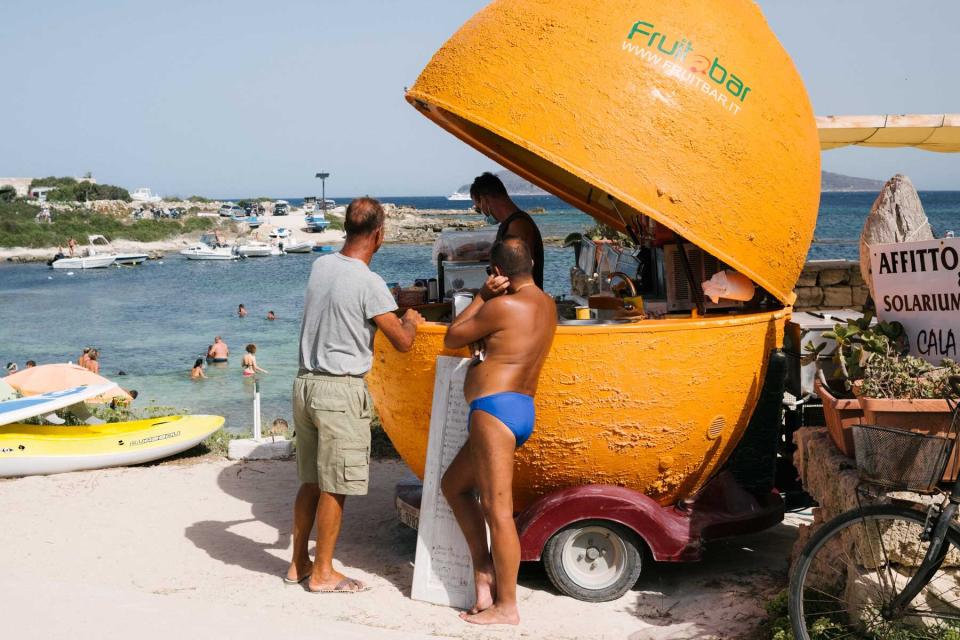
Federico Ciamei On orange-shaped juice bar on the island of Favignana.
A Sojourn in Sicily
Where to Stay
Cas'almare: Located on the island of Favignana, off Sicily's western coast, this five-room guesthouse with sweeping sea views is simple, spare, and comfortable.
Villa Igiea: The grande dame of Palermo, this 78-room,22-suite hotel has a long history. A recent renovation has restored the Liberty style décor of the property's heyday while incorporating contemporary accents.
How to Book
Andrea Grisdale (andrea@icbellagio.com; 39-0319-52059), a member of T+L's A-List of the world's best travel advisors, can work with her team at IC Bellagio — including Sicily specialist Marta Valsecchi — to assemble a visit to Palermo and the Egadi Islands. Highlights include a guided tour of the capital's antiquities and a cycling adventure on Favignana.
A version of this story first appeared in the May 2022 issue of Travel + Leisure under the headline A Sicilian Story.

